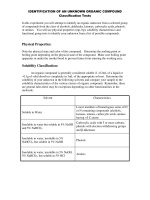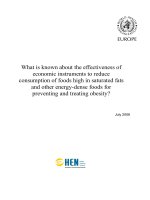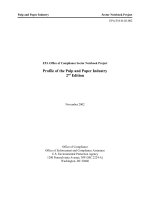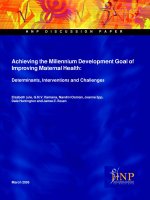Milestone 4: Identification of suitable high priority project interventions and selected smallholders for training and demonstration units and estimation of potential physical and financial impacts " doc
Bạn đang xem bản rút gọn của tài liệu. Xem và tải ngay bản đầy đủ của tài liệu tại đây (961.29 KB, 14 trang )
1
Milestone 4: Identification of suitable high priority project interventions and
selected smallholders for training and demonstration units and estimation of
potential physical and financial impacts
1) High priority project interventions include (and corresponding figures demonstrate):
• Modification and introduction of improvements to housing to improve ventilation,
temperature control and hygiene in pig sheds;
o Many buildings have insufficient ventilation with no cross ventilation
possible. Although some of these buildings could be renovated to reach a
satisfactory level, the best alternative would be for the farmer to build a
new building for pigs with input into the design by Vietnamese Scientists.
Figure 1. Improved shed design.
This new building has improved ventilation and hygiene
and has been elevated, to account for seasonal flooding in the area.
o While a number of buildings were well designed with good cross
ventilation, the side openings were covered with plastic blinds or covers.
In many of the farms, it appeared to be very labour intensive to open and
close them all the time. Simple systems to quickly raise or lower blinds
2
can be introduced. In many farms with low lying rooves a ceiling fan may
also improve air quality and heat index.
o A number of buildings had ridge vents which appear to work well and
give the farmer more options in controlling inside temperatures.
o Roofing material-tiles appear to be the best with thatched material the next
best and iron the worst option. One shed had an iron roof covered with
thatch and this seemed to work well. Whether this will reduce the life span
of the iron is unknown.
Figure 2. Ridge vents and a fibro roof.
Fibro roofing material provides very good
insulation against heat and is readily available so was used on many of the new sheds.
Ridge vents were also installed on some farms and provide very good ventilation.
o Many buildings have poor standard of hygiene associated with poor
ventilation and wet floors. Daily cleaning on many farms appears to have
a negative effect on overall hygiene and alternatives such as scraping
should be trialled.
o Improvement to hygiene levels could be made by creating outside dunging
areas, especially for sows, weaners and fatteners. This would create a drier
environment within the shed and give pigs the option of sitting on wet
cool floors under cover outside the shed or on dry warmer floors inside the
3
shed. Slats in these small piggeries would be costly to install and not
economically sustainable.
Figure 3. A pen with an outdoor dunging
area. The hygiene on this farm is excellent.
Sows can use the outdoor dunging area and
rest inside. Effluent drains away from the
pen, into fish ponds.
o Hygiene and temperature in many sheds is affected by dung drainage slots
at floor level in the outside wall. Some pens have 3 dung slots and some
have a long dung slot covered the width of the pen. These openings allow
cold draughts to enter the shed from outside, and this creates poor dunging
patterns and reduces hygiene and air quality levels.
Figure 4. Open gutter system.
The new shed designs include open gutter systems to drain
effluent away from the shed. Many older sheds have a system where effluent drains
4
directly onto compost pits; as air travels over the pits and into the shed, its quality is
reduced.
• Modification and adoption of improved farrowing crates, farrowing pen designs
and creep boxes with increased temperature control for piglets.
o Farrowing crate design need to be modified and a final design or designs
decided upon.
o Farrowing crates are only needed for F1 and Exotic sows as Mon Cai
seem to manage quite well without a farrowing crate.
Figure 5. Farrowing crate for an exotic sow.
Very few of the selected farms have exotic
sows, choosing instead to use exotic semen and Mong Cai sows and this was the only
farm where a farrowing crate was used. In line with previous reporting of the superior
mothering ability of Mong Cai sows, no death of F1 suckling piglets due to crushing was
reported.
o A creep box piglet sleeping area needs to be designed and the positioning
of lamps was discussed. It seems that it is cheaper and easier in this
environment to put a light inside the box rather than rest it on the cover as
in Australia. A solid front wall to the front of the creep box and two
openings (one at each corner) for the piglets was preferred.
5
Figure 6. Creep boxes.
Every farm in TTHue province has been supplied with a creep
box and further boxes made by the farmers will use this model. The same process is
occurring in Quang Tri. All sides of the creep box are enclosed, the flooring is removable
for cleaning and there are two openings and a light bulb, which provides warmth. Straw
is commonly added as bedding.
• Group housing in pens for dry sows with feeding stalls or half stalls is a priority.
However, the width is a problem because of the different breeds so it would seem
that best solution would be to develop adjustable dry sow feeding stalls.
Figure 7. Feeding stalls.
Two types of stalls were used on farms, full (left) and half
(right). These help to ensure a more evenly fed herd and less variation in growth
rates.
6
o Group housing in pens for dry sows with feeding stalls or half stalls is a
priority. However, the width is a problem because of the different breeds
so it would seem that best solution would be to develop adjustable dry sow
feeding stalls.
• Written, complete audible records in regular use on farm
Figure 8. Rigorous application of the herd auditing system will ensure that farmers
keep adequate production records essential for profitability.
• Pass a diet audit and have an ad lib feeding and water regime in place
Figure 9.
Supplementation of home mixed foods with vitamin and mineral premixes
is a common practice in rural Vietnam.
7
Figure 10.
Installation of automatic water nipples (in a new Quang Tri smallholder
piggery) at different heights provides ad lib water to sows and piglets.
• Acceptable heat detection methods and optimal AI
Figure 11. Exotic boar semen is added to the inseminator. Lack of boar stimulation
and poor technique result in inconsistent conception rates.
8
• Vaccination and treatment schedules in place and NIVR E. coli vaccine in use
Figure 12. The NIVR E. coli vaccine (Developed in CARD project 001/04VIE)
currently in use in the project. Two injections are given to gilts, 10 weeks and 3
weeks prior to parturition. This provides protective antibodies in colostrum which
protects piglets during the critical first week of life when they are most susceptible to
enterotoxigenic E. coli infection.
• Mange eradicated
o Mange has been evident to some extent on all farms we visited. Based on
figures from many pig-producing countries around the world, mange
causes a 10% decrease in average daily gain and a decrease in food
conversion efficiency of 0.1. Based on these figures alone the cost of
mange is $350 Aus/sow/year (4,200,000 Dong). The cost of eradication is
$5Aus/ breeder (60,000 Dong). This is a one off cost. The program should
be designed for each farm to minimise labour and cost of medication. This
assumes that treated animals do not come into contact with infected
weaners and growers until all infected animals have been sold off. This
can be easily achieved by having a buffer pen between animals of treated
breeders and infected animals. We can provide specific details based on a
diagram of the farm layout
9
Figure 13. Pig with severe sarcoptic mange
(
• Introduction of new improved Mong Cai breeding stock accomplished.
Figure 12. High performance pure Mong Cai gilts being raised at Thuy Phuong Pig
Research Center (currently managed by Dr Coi, former Vietnam Project Leader) for
delivery to selected farmers in Quang Tri province for the project. High performance
gilts were introduced into Thua Thien Hue province in April 2007, but outbreaks of
FMD and PRRS disease has prevented introduction of gilts to Quang Tri until April
2008.
10
• Pass a farm audit (electronic version) at each visit (including corrective actions)
o The shortened form of the electronic questionnaire and audit was
previously submitted as part of MS 3.
• Diagnostic surveillance for preweaning diarrhoea initiated.
Figure 13. Neonatal piglet with E. coli scours (A). To obtain a sample for diagnosis,
a dry swab is inserted into the rectum, placed into transport media (B) and mailed to
the NIVR diagnostic microbiology laboratory.
B
A
11
• Sow/ Litter cards kept detailing:
o Date of last weaning
o Date of service
o Number born, and date
o Number scouring, (duration of treatment, and a record of any samples
collected for NIVR)
o Age and speculative cause of death
o Number weaned and date
o Date of next service
(an example of a sow card is shown below [Word version on the next page]).
12
FARM Identification……………………….
Sow/farrowing details
Sow ID
D
ate farrowed Date weaned
Parity
N
os born alive Nos weaned
N
os born dead Fostered in
F
oetus/mummy Fostered out
Litter mortality details
Date Nos dead Death code Code for piglet death
Overlay 1
Scours 2
Splay legs 3
Runts 4
Pale/Bleeder 5
Unthrifty 6
Arthritis/Meningitis 7
Savaged 8
Cold/exposed 9
Accident 10
Deformed 11
Hernia 12
Unknown 13
Treatment records
Piglet/litter treatment Sow treatment Treatment code
D
ate Nos treated Treatment code
D
ate Treatment code
Antibiotic oral O
Antibiotic injection A
Iron I
Fluid oral F
Fluid drinker D
Oxytocin X
Stresnil S
Manual delivery M
Other V
13
• Strong encouragement to build new pig facilities (rather than renovate old
facilities as knowhow is developed and production improved) to the specification
designed by Vietnamese trainees (previously reported in MS 3).
Figure 14. The first pure Mong Cai piggery in Quang Tri purpose-built to the
specification developed by Vietnamese trainee scientists. Note the open sides with
blinds that can be easily raised or lowered, the high ceiling allowing for adequate
cross ventilation and the ridge vent allowing hot air to rise and escape. The piggery is
made from cheap, cost effective materials.
14
2) Estimation of potential physical and financial impacts.
Given that ideal production parameters are maintained, the target reproduction rate
should be 2.2 litters/mated/sow/year with an average litter size of 12 and a weaning target
of 10. Vietnamese farmers sell their pigs at various ages, with sale at 7-10 kg common.
Reported price variation has been between 10,000-45,000 Dong, with pig prices rising
sharply as a consequence of FMD and PRRS outbreaks throughout China and South East
Asia. Given a herd size of approximately 10 sows, a farmer’s target maximum gross
income (based on 220 pigs per year) would therefore be close to 100 million Dong
($6,600 AUD).
Once demonstration farms are completely set up and farmers have achieved all of the
high priority project interventions set out above, it will be possible to calculate their total
input costs and profit margins. The cost to production of not achieving each of these
milestone goals can also be calculated as a means of continually encouraging farmers to
improve their production and therefore their bottom line.
Our aim is for our selected farmers to become community leaders and produce breeding
stock for neighbouring farmers (highly lucrative). Farmers that do not have the skill level,
resources and facilities required to keep sows may choose to fatten grower pigs as a less
risky Agribusiness venture.









